Water world: a mesmerising installation by Bureau de Change unfurls
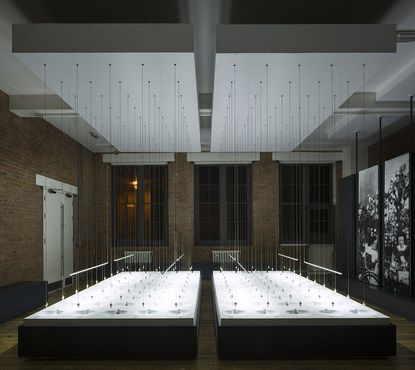
Bringing together Clerkenwell’s rich industrial history and the Sto Group's range of IQ façade finishes, dynamic young architecture practice Bureau de Change has just unveiled a captivating installation at the manufacturer’s London gallery space, Sto Werkstatt.
Entitled ‘Droplet’, the piece is a ‘sensorial’ installation, explain the architecture firm’s directors, Billy Mavropoulos and Katerina Dionysopoulou. ‘The main challenge of the brief was how we could utilise a product whose "magic" effect is essentially invisible,’ adds Dionysopoulou. ‘The installation sets up a "compare and contrast" scenario, whereby the IQ coating can be seen working in a live way.’
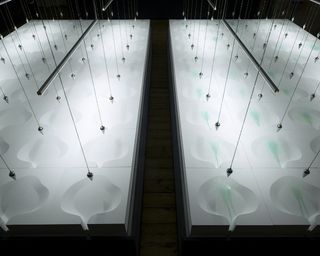
Installation view of 'Droplet'.
A visit does not disappoint. The display, arranged in a grid formation, consists of 100 elegantly made pendulums and a three-dimensional surface of 100 petal-like forms below them. Tinted water drips down the pendulums’ chains onto the sculptural carved forms underneath – which are CNC'd from Sto’s lightweight façade material Verolith – creating an ever-changing pattern within this calmly energetic piece. A soundtrack of water dripping completes the effect.
'We are using a set of the company’s intelligent paints – one that repels water and one that doesn't,' explains Mavropoulos. ‘The texture of the water-repellent pain replicates properties of the lotus plant, which allows water to glide over it smoothly.’
The site-specific installation also drew on the Sto building’s history, which at the end of the 1800s and beginning of the 1900s was part of the John Groom Foundation, which employed disadvantaged women in flower-making (creating flowers out of textiles was big business in London at the time).
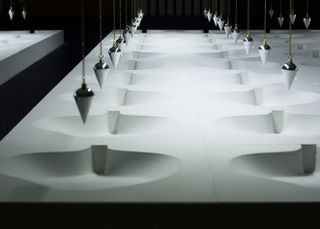
The installation's base is CNC'd into a pattern of lotus leaves, referencing the way the plant interacts with water.
'We worked with the Metropolitan Archives, which are situated around the corner, and borrowed their flower-making tools, which we 3D-scanned and 3D-printed to display them here,' continues Mavropoulos. ‘These helped inspire the petal shapes in the installation. Even the pendulums refer back to Clerkenwell’s history and specifically its long tradition in clock-making.’
The multi-layered show aims to unfold the area’s different historic layers, while offering a dynamic display that engages the visitor, and an inspiring showcase of Sto’s cutting-edge product.
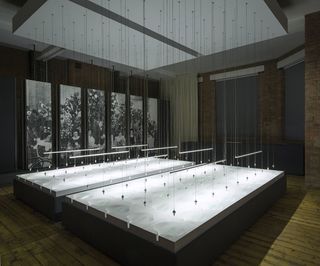
The exhibition shows delicate pendulums hanging from the ceiling. These guide tinted water that drops onto a leaf-inspired three-dimensional base below, creating patterns
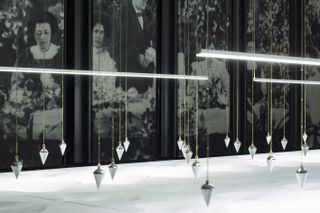
The architects tapped into the area's history and specifically the Sto Werkstatt building's history as a flower-making facility in Victorian times

Two types of tinted water are used – one that is completely water resistant, and one that isn't, emphasising the different effect each creates
INFORMATION
’Droplet’ is on view until 16 December. For more information, visit the Sto Werkstatt London website
ADDRESS
Sto Werkstatt
7–9 Woodbridge Street
London EC1R 0LL
Wallpaper* Newsletter
Receive our daily digest of inspiration, escapism and design stories from around the world direct to your inbox
Ellie Stathaki is the Architecture & Environment Director at Wallpaper*. She trained as an architect at the Aristotle University of Thessaloniki in Greece and studied architectural history at the Bartlett in London. Now an established journalist, she has been a member of the Wallpaper* team since 2006, visiting buildings across the globe and interviewing leading architects such as Tadao Ando and Rem Koolhaas. Ellie has also taken part in judging panels, moderated events, curated shows and contributed in books, such as The Contemporary House (Thames & Hudson, 2018), Glenn Sestig Architecture Diary (2020) and House London (2022).
-
 A new limited-edition Rhodes piano and Gibson doubleneck guitar aim for the stars
A new limited-edition Rhodes piano and Gibson doubleneck guitar aim for the starsThe new Rhodes Mk8 Earth Edition piano and Gibson Jimmy Page EDS-1275 Doubleneck guitar revisit classic instruments at a price
By Jonathan Bell Published
-
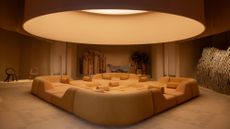 The new interior design trends we spotted at Salone del Mobile 2024
The new interior design trends we spotted at Salone del Mobile 2024These are the interior design trends to look out for in 2024 and beyond, from soft upholstery to conversation pits and low dining
By Rosa Bertoli Published
-
 Tiffany & Co nods to its theatrical history with a surreal new campaign
Tiffany & Co nods to its theatrical history with a surreal new campaignTiffany & Co campaign ‘With Love, Since 1837’ sees Dan Tobin Smith and set designer Rachel Thomas create an offbeat set
By Hannah Silver Published
-
 London’s Reciprocal House complements an existing Norman Foster extension
London’s Reciprocal House complements an existing Norman Foster extensionReciprocal House by Gianni Botsford replaces a north London Victorian structure, preserving its early Norman Foster extension and bringing the whole to the 21st century
By Ellie Stathaki Published
-
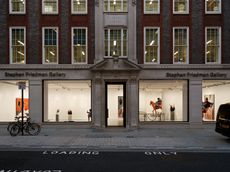 Stephen Friedman Gallery by David Kohn is infused with subtly playful elegance
Stephen Friedman Gallery by David Kohn is infused with subtly playful eleganceStephen Friedman Gallery gets a new home by David Kohn in London, filled with elegant details and colourful accents
By Ellie Stathaki Published
-
 Henry Wood House’s postmodernist bones are refreshed by Nice Projects in London
Henry Wood House’s postmodernist bones are refreshed by Nice Projects in LondonNice Projects breathes new life into the Henry Wood House in London, offering ample flexible office spaces for modern workers
By Daven Wu Published
-
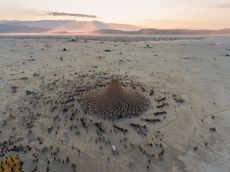 ‘Bio-spaces’ exhibition at Roca London Gallery celebrates biophilic design
‘Bio-spaces’ exhibition at Roca London Gallery celebrates biophilic design‘Bio-Spaces: regenerative, resilient futures’ opens at the Roca London Gallery as ‘a call to action to stop designing nature out’
By Clare Dowdy Published
-
 Don’t Move, Improve 2024: London’s bold, bright and boutique home renovations
Don’t Move, Improve 2024: London’s bold, bright and boutique home renovationsDon’t Move, Improve 2024 reveals its shortlist, with 16 home designs competing for the top spot, to be announced in May
By Ellie Stathaki Published
-
 Timber-framed Wimbledon house is a minimalist, low-energy affair
Timber-framed Wimbledon house is a minimalist, low-energy affairA new timber-framed Wimbledon house is designed to blend into its traditional surroundings with a neat brick façade, careful massing and pared back interiors
By Jonathan Bell Published
-
 London Science Museum’s Energy Revolution gallery champions sustainable exhibition design
London Science Museum’s Energy Revolution gallery champions sustainable exhibition designThe Energy Revolution gallery opens at London’s Science Museum, exploring decarbonisation through sustainable exhibition design by Unknown Works
By Ellie Stathaki Published
-
 This South Downs house stands as a testament to the value of quiet refinement
This South Downs house stands as a testament to the value of quiet refinementAt one with the landscape, a South Downs house uses elements of quintessential country villas and midcentury gems with modern technologies
By Jonathan Bell Published